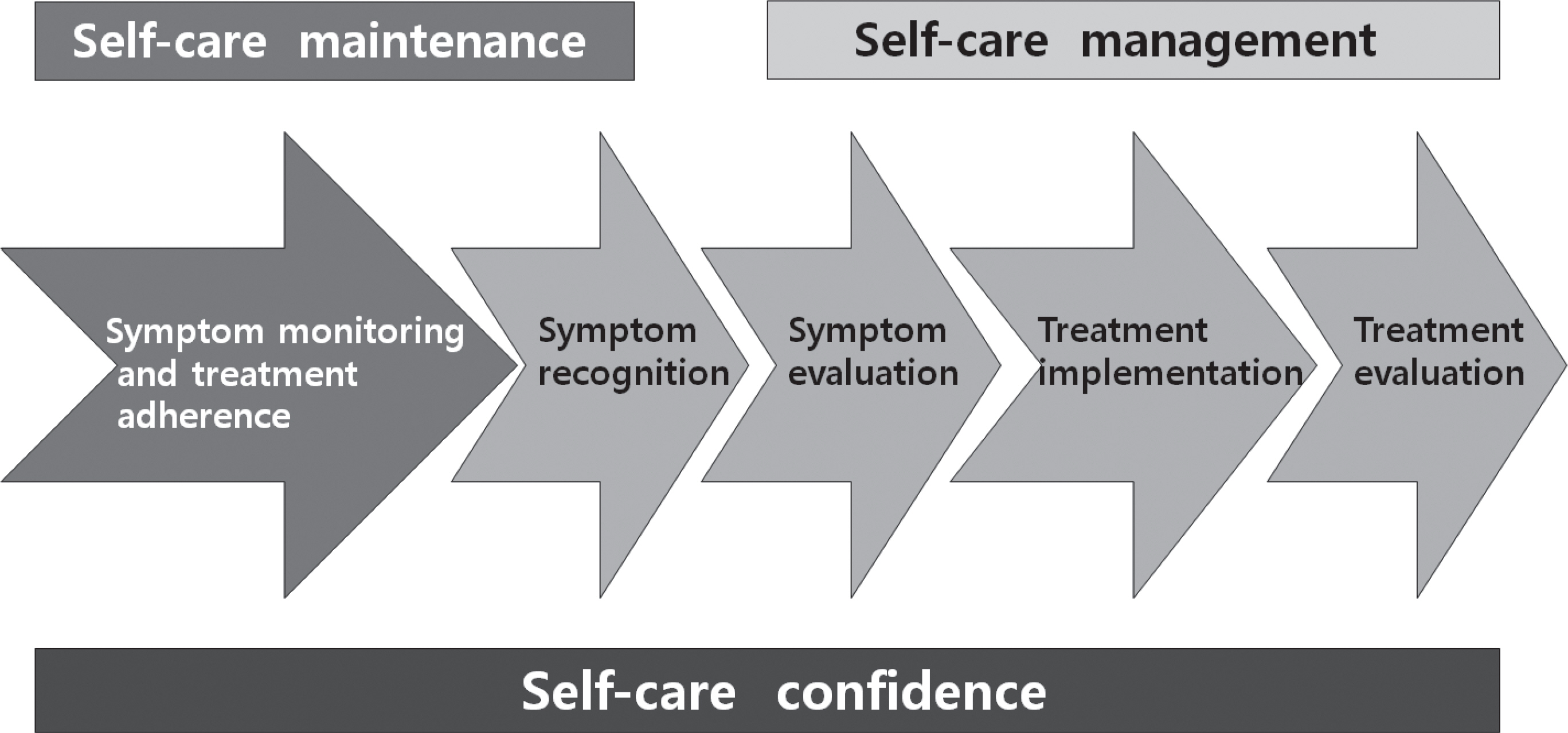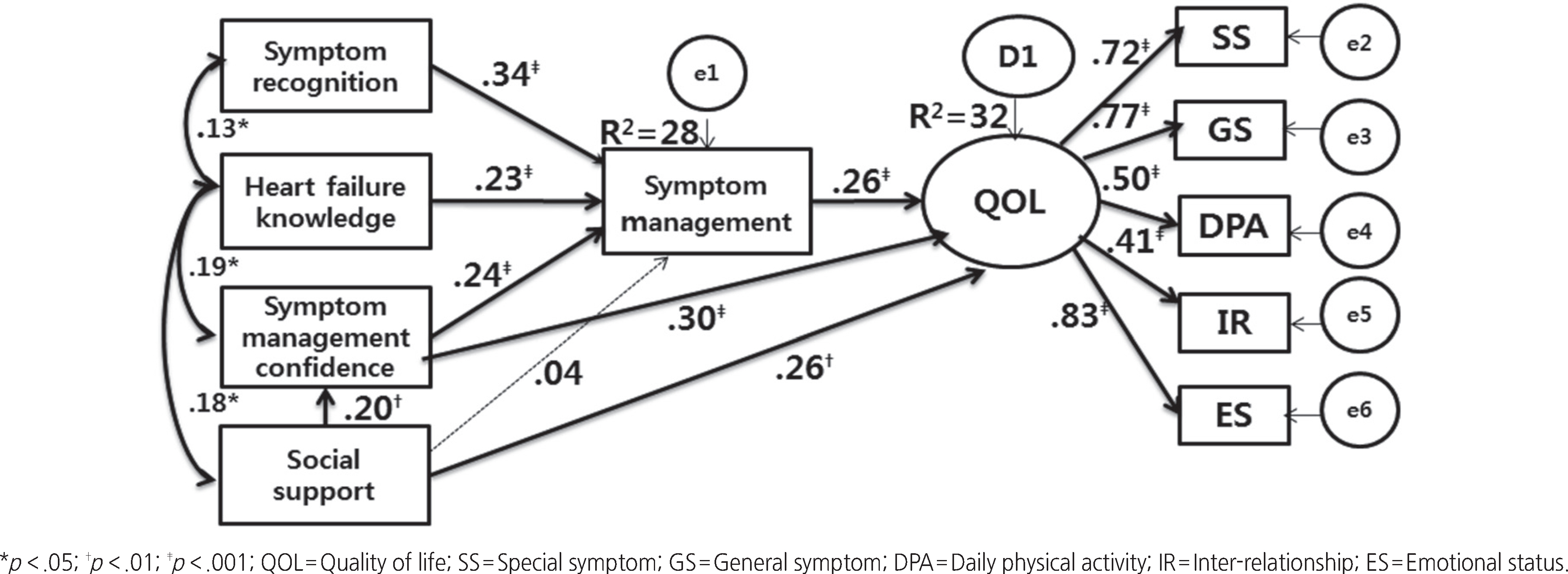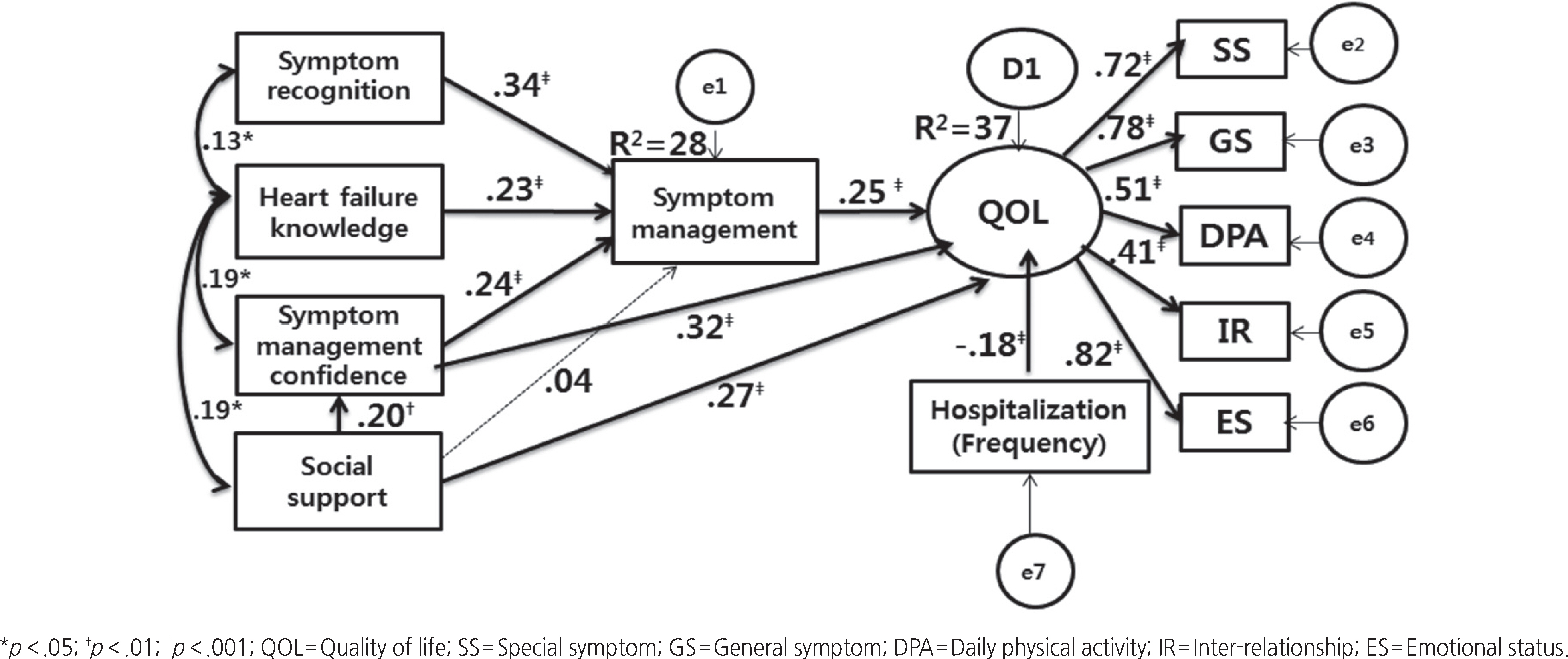Articles
- Page Path
- HOME > J Korean Acad Nurs > Volume 45(6); 2015 > Article
-
Original Article
- Symptom Management to Predict Quality of Life in Patients with Heart Failure: A Structural Equation Modeling Approach
- Ja Ok Lee1, Rhayun Song2
-
Journal of Korean Academy of Nursing 2015;45(6):846-856.
DOI: https://doi.org/10.4040/jkan.2015.45.6.846
Published online: December 15, 2015
1The Catholic University Daejeon St. Mary's Hospital, Daejeon
2College of Nursing, Chungnam National University, Daejeon, Korea
1The Catholic University Daejeon St. Mary's Hospital, Daejeon
2College of Nursing, Chungnam National University, Daejeon, Korea
- Address reprint requests to : Song, Rhayun College of Nursing, Chungnam National University, 266 Munwha-ro, Jung-gu, Daejeon 35015, Korea Tel: +82-42-580-8331 Fax: +82-42-584-8915 E-mail: songry@cnu.ac.kr
Copyright © 2015 Korean Society of Nursing Science
This is an Open Access article distributed under the terms of the Creative Commons Attribution NoDerivs License. (http://creativecommons.org/licenses/by-nd/4.0) If the original work is properly cited and retained without any modification or reproduction, it can be used and re-distributed in any format and medium.
Abstract
-
Purpose
- The focus of this study was on symptom management to predict quality of life among individuals with heart failure. The theoretical model was constructed based on situation-specific theory of heart failure self-care and literature review.
-
Methods
- For participants, 241 outpatients at a university hospital were invited to the study from May 19 to July 30, 2014. Data were collected with structured questionnaires and analyzed using SPSSWIN and AMOS 20.0.
-
Results
- The goodness of fit index for the hypothetical model was .93, incremental fit index, .90, and comparative fit index, .90. As the outcomes satisfied the recommended level, the hypothetical model appeared to fit the data. Seven of the eight hypotheses selected for the hypothetical model were statistically significant. The predictors of symptom management, symptom management confidence and social support together explained 32% of the variance in quality of life. The 28% of variance in symptom management was explained by symptom recognition, heart failure knowledge and symptom management confidence. The 4% of variance in symptom management confidence was explained by social support.
-
Conclusion
- The hypothetical model of this study was confirmed to be adequate in explaining and predicting quality of life among patients with heart failure through symptom management. Effective strategies to improve quality of life among patients with heart failure should focus on symptom management. Symptom management can be enhanced by providing educational programs, encouraging social support and confidence, consequently improving quality of life among this population.
| Model | χ2 | DF | p | χ2/df | GFI | SRMR | RMSEA | IFI | CFI |
|---|---|---|---|---|---|---|---|---|---|
| Evaluation criteria | − | − | > .05 | <3 | ≥.90 | ≤.05 | ≤.10 | ≥.90 | ≥.90 |
| Hypothetical model | 88.15 | 29 | < .001 | 3.04 | .93 | .06 | .09 | .90 | .90 |
- 1. The Korean Society of Circulation, Heart Failure Study Group. The manual of heart failure. Seoul: MMK Communications; 2007.
- 2. Riegel B, Lee CS, Dickson VV, Carlson B. An update on the self- care of heart failure index. The Journal of Cardiovascular Nursing. 2009;24(6):485–497. http://dx.doi.org/10.1097/JCN.0b013e3181b4baa0ArticlePubMedPMC
- 3. Son YJ, Kim SH, Kim GY. Factors influencing adherence to self care in patients with chronic heart failure. Korean Journal of Adult Nursing. 2011;23(3):244–254.
- 4. Statistics Korea. 2013 annual report on the cause of death statis- tics. Daejeon: Author; 2014.
- 5. Lee ES, Shin ES, Hwang SY, Chae MJ, Jeong MH. Effects of tai- lored supportive education on physical, emotional status and quality of life in patients with congestive heart failure. Korean Journal of Adult Nursing. 2013;25(1):62–73. http://dx.doi.org/10.7475/kjan.2013.25.1.62ArticlePDF
- 6. Ahmed A. Chronic heart failure in older adults. The Medical Clin- ics of North America. 2011;95(3):439–461. http://dx.doi.org/10.1016/j.mcna.2011.02.001Article
- 7. Blinderman CD, Homel P, Billings JA, Portenoy RK, Tennstedt SL. Symptom distress and quality of life in patients with advanced congestive heart failure. Journal of Pain and Symptom Manage- ment. 2008;35(6):594–603. http://dx.doi.org/10.1016/j.jpainsymman.2007.06.007Article
- 8. Zambroski CH, Moser DK, Bhat G, Ziegler C. Impact of symptom prevalence and symptom burden on quality of life in patients with heart failure. European Journal of Cardiovascular Nursing. 2005;4(3):198–206. http://dx.doi.org/10.1016/j.ejcnurse.2005.03.010ArticlePubMedPDF
- 10. Jurgens CY, Lee CS, Reitano JM, Riegel B. Heart failure symptom monitoring and response training. Heart and Lung. 2013;42(4):273–280. http://dx.doi.org/10.1016/j.hrtlng.2013.03.005ArticlePubMed
- 11. Dodd M, Janson S, Facione N, Faucett J, Froelicher ES, Hum- phreys J, et al. Advancing the science of symptom management. Journal of Advanced Nursing. 2001;33(5):668–676. http://dx.doi.org/10.1046/j.1365-2648.2001.01697.xArticlePubMed
- 12. Riegel B, Dickson VV. A situation-specific theory of heart failure self-care. The Journal of Cardiovascular Nursing. 2008;23(3):190–196. http://dx.doi.org/10.1097/01.jcn.0000305091.35259.85ArticlePubMed
- 13. Gallagher R, Luttik ML, Jaarsma T. Social support and self-care in heart failure. The Journal of Cardiovascular Nursing. 2011;26(6):439–445. http://dx.doi.org/10.1097/JCN.0b013e31820984e1ArticlePubMed
- 14. Graven LJ, Grant JS. Social support and self-care behaviors in in- dividuals with heart failure: An integrative review. International Journal of Nursing Studies. 2014;51(2):320–333. http://dx.doi.org/10.1016/j.ijnurstu.2013.06.013ArticlePubMed
- 15. Lee SH, Ahn SH. Self care compliance, family support, and de- pression in patients with congestive heart failure. Journal of Korean Academy of Fundamentals of Nursing. 2005;12(2):186–194.
- 16. Lainscak M, Keber I. Validation of self assessment patient knowl- edge questionnaire for heart failure patients. European Journal of Cardiovascular Nursing. 2005;4(4):269–272.ArticlePubMedPDF
- 17. Kim YS. A path analysis model of health-related quality of life in patients with heart failure. Journal of Korean Academy of Adult Nursing. 2007;19(4):547–555.
- 18. Krethong P, Jirapaet V, Jitpanya C, Sloan R. A causal model of health-related quality of life in Thai patients with heart-failure. Journal of Nursing Scholarship. 2008;40(3):254–260. http://dx.doi.org/10.1111/j.1547-5069.2008.00235.xArticlePubMed
- 19. Yu JP. The concept and understanding of structural equation mod- eling. Seoul: Hannare Publishing Co.; 2012.
- 20. Cobb S. Presidential address-1976. Social support as a moderator of life stress. Psychosomatic Medicine. 1976;38(5):300–314.ArticlePubMed
- 21. Kang HS. An experimental study of the effects of reinforcement education for rehabilitation on hemiplegia patients’ self-care activ- ities [dissertation]. Seoul: Yonsei University; 1984.
- 22. Lee EH, Tahk SJ, Shin JH, Lee YW, Song R. Development and a psychometric evaluation of cardiovascular disease-specific quality of life scale for Koreans. Journal of Korean Academy of Nursing. 2007;37(3):313–323.ArticlePubMedPDF
- 23. Charlson ME, Pompei P, Ales KL, MacKenzie CR. A new method of classifying prognostic comorbidity in longitudinal studies: Devel- opment and validation. Journal of Chronic Diseases. 1987;40(5):373–383. http://dx.doi.org/10.1016/0021-9681(87)90171-8ArticlePubMed
- 24. Vellone E, Riegel B, D’Agostino F, Fida R, Rocco G, Cocchieri A, et al. Structural equation model testing the situation-specific the- ory of heart failure self-care. Journal of Advanced Nursing. 2013;69(11):2481–2492. http://dx.doi.org/10.1111/jan.12126ArticlePubMedPDF
- 25. Riegel B, Dickson VV, Cameron J, Johnson JC, Bunker S, Page K, et al. Symptom recognition in elders with heart failure. Journal of Nursing Scholarship. 2010;42(1):92–100. http://dx.doi.org/10.1111/j.1547-5069.2010.01333.xArticlePubMed
- 26. Mata J, Frank R, Gigerenzer G. Symptom recognition of heart at- tack and stroke in nine European countries: A representative sur- vey. Health Expectations. 2014;17(3):376–387. http://dx.doi.org/10.1111/j.1369-7625.2011.00764.xArticlePubMed
- 27. Cen CW, Haymore LB, Dolan-Soto D, Lin FC, Pignone M, Dewalt DA, et al. Self-care confidence mediates the relationship between perceived social support and self-care maintenance in adults with heart failure. Journal of Cardiac Failure. 2013;19(3):202–210. http://dx.doi.org/10.1016/j.cardfail.2013.01.009ArticlePubMedPMC
- 28. Kim HN. Symptom experience, symptom management strategies and health-related quality of life in patients with pancreatic cancer [master’s thesis]. Seoul: Yonsei University; 2013.
- 29. Kato N, Kinugawa K, Ito N, Yao A, Watanabe M, Imai Y, et al. Adherence to self-care behavior and factors related to this behav- ior among patients with heart failure in Japan. Heart and Lung. 2009;38(5):398–409. http://dx.doi.org/10.1016/j.hrtlng.2008.11.002ArticlePubMed
- 30. Song EK, Kim CJ, Yoo IY, Kim GY, Kim JH, Ha JW. Factors in-fluencing functional status in patients with heart failure. Journal of Korean Academy of Nursing. 2006;36(5):853–862.ArticlePubMedPDF
REFERENCES
Figure & Data
REFERENCES
Citations

- Correlation between symptom status, health perception, and spiritual well‐being in heart failure patients: A structural equation modeling approach
Hacer Eroglu, Zehra Gok Metin
Journal of Nursing Scholarship.2024; 56(4): 490. CrossRef - Factors associated with self-care behaviours among Koreans with heart failure
Choung Ryou, Seok-Min Kang, Yeonsoo Jang
European Journal of Cardiovascular Nursing.2021; 20(1): 64. CrossRef - Association Between Symptoms of Patients With Heart Failure and Patient Outcomes Based on Electronic Nursing Records
Seung Yeon Baik, Gi Wook Ryu, Hyangkyu Lee, Siwook Lee, Mona Choi
CIN: Computers, Informatics, Nursing.2021; 39(12): 1027. CrossRef - Factors associated with health-related quality of life in Chinese patients with heart failure: a cross-sectional study
Guangpeng Wang, Qingmin Yang
Collegian.2020; 27(5): 512. CrossRef - Symptom clusters and quality of life in Chinese patients with heart failure
Guangpeng Wang, Xueyan Liu, Qingmin Yang
Collegian.2020; 27(5): 521. CrossRef - Prediction of Heart Failure Symptoms and Health-Related Quality of Life at 12 Months From Baseline Modifiable Factors in Patients With Heart Failure
Seongkum Heo, Debra K. Moser, Terry A. Lennie, Mary Fischer, JinShil Kim, Mary N. Walsh, Songthip Ounpraseuth, Stephanie Turrise
Journal of Cardiovascular Nursing.2020; 35(2): 116. CrossRef - Gene expression and levels of IL-6 and TNFα in PBMCs correlate with severity and functional class in patients with chronic heart failure
V. Eskandari, A. A. Amirzargar, M. J. Mahmoudi, Z. Rahnemoon, F. Rahmani, S. Sadati, Z. Rahmati, F. Gorzin, M. Hedayat, N. Rezaei
Irish Journal of Medical Science (1971 -).2018; 187(2): 359. CrossRef



Figure 1.
Figure 2.
Figure 3.
| Model | χ2 | DF | p | χ2/df | GFI | SRMR | RMSEA | IFI | CFI |
|---|---|---|---|---|---|---|---|---|---|
| Evaluation criteria | − | − | > .05 | <3 | ≥.90 | ≤.05 | ≤.10 | ≥.90 | ≥.90 |
| Hypothetical model | 88.15 | 29 | < .001 | 3.04 | .93 | .06 | .09 | .90 | .90 |
| Endogenous variables | Exogenous variables | Hypothetical model |
Direct effect |
Indirect effect |
Total effect |
||
|---|---|---|---|---|---|---|---|
| SRW (SE) | C.R (p) | SMC | p | p | p | ||
| SM confidence | Social support | .20 (.04) | 3.23 (.001) | .04 | .20 (.004) | .20 (.004) | |
| Symptom | S recognition | .34 (.13) | 6.08 (.001) | .28 | .34 (.021) | .34 (.021) | |
| management | HF knowledge | .23 (.07) | 4.05 (< .001) | .23 (.003) | .23 (.003) | ||
| SM confidence | .24 (.04) | 4.24 (< .001) | .24 (.008) | .24 (.008) | |||
| Social support | .04 (.02) | 0.64 (.525) | .04 (.676) | .05 (.004) | .09 (.116) | ||
| Quality of life | S recognition | .32 | .09 (.007) | .09 (.007) | |||
| HF knowledge | .06 (.002) | .06 (.002) | |||||
| SM confidence | .30 (.05) | 4.51 (< .001) | .30 (.008) | .06 (.004) | .37 (.016) | ||
| S management | .26 (.07) | 4.02 (< .001) | .26 (.009) | .26 (.009) | |||
| Social support | .26 (.03) | 4.01 (< .001) | 26 (.007) | .08 (.003) | .34 (.010) | ||
GFI=Goodness of fit index; SRMR=Standardized root mean residual; RMSEA=Root mean squared error of approximation; IFI=Incremental fit index; CFI=Comparative fit index.
SRW=Standardized regression weight; C.R=Critical ratio; SMC=Squared multiple correlation; HF=Heart failure; SM=Symptom management; S=Symptom.
 KSNS
KSNS
 E-SUBMISSION
E-SUBMISSION



 Cite
Cite

